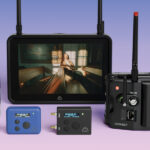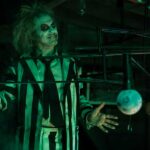
Agencies Sold on Virtual Space
Posted on Sep 17, 2024 by Samara Husbands
The commercials market is beginning to adopt virtual production as a way to deliver cost-efficiency, creativity and sustainability
Words by Adrian Pennington
The soft TV advertising market might expect to be reflected in a downturn in demand for production. However, shooting campaign spots in a volume – without the expense of going on location – is becoming a key way of controlling budgets.
Director and DOP Rob Payton, who consults for ARRI Stage London, says the company is seeing a significant increase in enquiries for commercials. There are three clear drivers for this: cost-efficiencies, sustainability agendas and the creativity that working in VP brings.
“Interestingly, this change is client-led, with many blue-chip companies advocating VP to their agencies and production houses,” he says. “Many talented commercial directors, despite their extensive experience, have not worked in a volume before, and we want them to treat it like any other location using familiar tools and techniques. My advice: maximise your prep time. What traditionally may have been one-day prep, two-day shoot could now be three-day prep, one-day shoot. If screen content and previs are optimised in prep, it is incredible how much can be shot in a single day.”
Chris Chaundler, MD at Quite Brilliant, says that business is ‘stable’ but stresses the importance of examining the context of the market over the last 18 months.
“Demand has picked up but there’s a huge gap between interest and conversion,” he says. “VP is still in the ‘proving itself’ phase. Brands are very interested because of the efficiency and sustainability benefits, but agency decision-making is done by creatives and sustainability isn’t high on the agenda. Directors and production companies are open to virtual production, but first and foremost they need to win the bid and make the budget work, so VP often gets overlooked in favour of cheaper overseas options.”
With some production budgets and turnaround times being scaled back, the need for production innovation and practical solutions is bigger than ever. “Maintaining creativity and variety across content is key for our clients,” says Bee Devine, Garden Studios COO. “Working on a VP stage, productions are able to turn around multiple scenes and shoot in a variety of locations within a single day – and do this sustainably. Our scalable VP solutions cater for every budget level, from small-scale car shoots to larger- scale complex scenes.”
The London-based studio Quite Brilliant claims to be the ‘go-to’ VP expert for the advertising and content market. “It’s a huge advantage coming from the world of advertising, as we understand how clients and agencies work and can manage their expectations and workflows,” says Chaundler. “What’s ‘good enough’ for many people in the Unreal Engine/gaming world often doesn’t cut it in creative advertising.
“I would say make sure you go with a supplier who has actually produced a lot of VP projects. I know this sounds obvious, but this is a new technology and commercials are more challenging, as there are more stakeholders and usually less pre-production time. You need the right people overseeing the pre-production/previs stages, as this is where the heavy lifting is done.”
Quite Brilliant made a safety video for Lufthansa earlier this year which required more than ten global locations with seamless transitions between each. To stretch the budget, it shot across different stages: MARS Volume for wides, Twickenham Film Studios for interiors and tights and a pop-up in the back of the studio for the driving scenes. Using a mix of Unreal assets and plates, they shot all transitions in camera. “The key with making a challenging project like this work was a flexible and collaborative approach during creative development and pre-production,” states Chaundler.
With the way the VP hardware works, so many technical parts need to come together to make virtual production function effectively. So, planning how it’s all going to combine beforehand and spending a considerable amount of time in pre-production is crucial.
“For example, if you’ve not done a storyboard, there’s no plan – and we don’t know what shots we are trying to achieve,” says Dan Hall, head of ICVFX and advanced technologies for 80six. “We don’t know what camera or lenses are planned and we can’t spec an accurate LED product and volume size.
“So, you could find yourself in a situation where the pixel pitch could be incorrect, or the volume is the wrong shape or size. This will result in challenges on-set that could have been avoided.”
With good structures in place, agencies can shoot whole commercials in many different locations over one day from the comfort of a studio, but it needs to be properly scheduled.
“Let’s say you discovered on-set that you have the incorrect volume size. You’ll then have to change the shot or redress the art department and move things around,” says Hall. “That’s hassle which takes up your shooting time. The VP supervisor should be involved in pre-production as soon as possible, having these conversations with the DOP and producers before shooting starts. I appreciate some projects need a quick turnaround, but if you don’t have that time, there will be limitations on-set.”
Where is tech going?
As with everywhere, AI is the buzzword. “I foresee an increased use of AI in content creation, enabling more cost-effective content creation and a faster turnaround,” according to Payton.
Chaundler predicts a jump in the number of TV ads shot in VP. “Brands are now more receptive and looking at ways to make production more efficient and sustainable,” he claims. “The good news is the technology is getting better and costs are coming down. Every new iteration of Unreal Engine sees a leap in quality and we are literally building a photorealistic CGI world. Soon, we’ll have ‘digital twins’ for everything from products to locations, like supermarkets or restaurants, which will open a whole new world of filming opportunities.”
AI will play a big role, he adds, but not in isolation. “Increasingly, TV commercials (TVCs) will be concepted and executed without a camera being lifted. Exciting and terrifying in equal measure!”
For Hall, the most exciting advancements to affect the TV commercial side of VP are radiance fields (NeRFs and Gaussian splatting).
“Radiance fields are similar to photogrammetry, where you take a lot of photos of an object or an area and can essentially replicate a 3D environment out of it,” he explains. “This technology will be revolutionary for commercial production. I’ve seen instances where a production needed to shoot a commercial in a bar – but only had access to the bar for a short amount of time when it was closed. They generated a radiance field and were able to replicate the bar in VP under different lighting conditions with multiple actors, so were able to shoot the entire commercial using virtual production.”
Amazon Bloom
Amazon Business’ ‘Bloom’ commercial shot at ARRI Stage London used virtual production for a unique take on a business growing from local to international.
Conceived by London-based Joint and produced by Outsider, the film follows a small flower stall transforming into a store, then floral empire, all in one continuous, choreographed take: the signature style of directing duo DOM&NIC. Motion control, precise camera FIZ data and real-time lighting changes were all deployed for a seamless feel throughout multiple 3D environments.
Pirate’s Grog
The team at Garden Studios has worked on large-scale commercials with larger sets and physical action, filming TV and social content in under a week. “We’ve also done smaller projects in a couple of days,” says Devine.
“A great example is an advert we shot with rum company Pirate’s Grog. This was all done in front of a live audience with three locations, which would only be possible in VP.” It used a 25x5m stage divided into three:
- A rowing boat in a thunderstorm, complete with rain rig and lighting fixtures synced to lightning flashes in Unreal Engine using DMX.
- A cave system with self-illuminating candles and an in-camera transition to a storm of gold confetti.
- An Indiana Jones-esque boulder run using a treadmill, with live pyro, again synced with the Unreal Engine content.
Garden also used a 3x2m ‘tabletop’ stage for pack shots with a second unit. The director was Tom Clarkson, working with DOP Sam Kemp, and other tech partners included MACHINESHOP, Focus Canning, Brompton Technology, Anna Valley, Mo-Sys and L-Acoustics.
“Planning in advance, building a robust workflow and scheduling shots effectively are all keys to success,” says Devine. “This includes creating a storyboard, having the 3D assets or video content ready and tested. It’s also beneficial for our VP team to support projects at the early stage and to be on board to solve potential technical problems in advance – leaving time for creativity and flexibility on-set.”
This feature was first published in the October 2024 issue of Definition.









